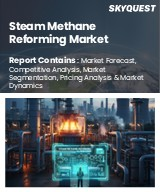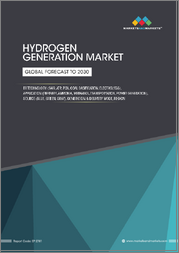
|
시장보고서
상품코드
1620449
세계의 전해 캡티브 수소 생성 시장 : 성장 기회, 성장 촉진요인, 산업 동향 분석 및 예측(2024-2032년)Electrolysis Captive Hydrogen Generation Market Opportunity, Growth Drivers, Industry Trend Analysis, and Forecast 2024 - 2032 |
||||||
전해 캡티브 수소 생성 세계 시장은 2023년에 111억 달러로 평가되었으며, 2024-2032년 사이에 CAGR 7%로 성장할 것으로 예상됩니다. 이 시장의 핵심은 전기 분해를 사용하여 물을 수소와 산소로 분해하는 공정으로 산업 시설 및 발전소에서 현장 수소 생산입니다. 이 방법은 널리 배포되는 것이 아니라 사내 및 국지 사용을 위해 설계되었습니다. 보다 깨끗한 에너지에 대한 수요 증가와 온실가스 배출 감축의 필요성이 수소생성에 전해를 채용하는 주요 요인이 되고 있습니다. 수소를 생산할 수 있으며 엄격한 환경 규제 및 지속가능성 목표를 준수하는 데 도움이 됩니다.
또한 녹색수소제조에 대한 세제우대조치나 보조금 등 정부의 지원시책이 이 청정기술로의 이행을 가속화하고 있습니다. 보다 깨끗한 제조 방법으로서 전해에 점점 주목 받고 있습니다. 많은 대규모 시설에서는 태양광이나 풍력 등의 재생 가능 에너지를 수소 제조의 전력원으로서 통합해, 안정적이고 비용 효율적인 클린 연료 공급을 보장합니다. 이 전환은 또한 외부 에너지 소스와 송전망에 대한 의존도를 줄이는 데 도움이 됩니다.
아시아태평양은 큰 성장을 이루려고 하며, 전해 캡티브 수소 생성 시장은 2032년까지 120억 달러 이상에 달할 것으로 예상되고 있습니다. 강력한 수소 시책과 함께 급속한 산업화가 이 부문을 뒷받침하고 있습니다.
| 시장 범위 | |
|---|---|
| 시작년 | 2023년 |
| 예측년 | 2024-2032년 |
| 시작금액 | 111억 달러 |
| 예측 금액 | 200억 달러 |
| CAGR | 7% |
목차
제1장 조사 방법과 조사 범위
제2장 주요 요약
제3장 산업 인사이트
- 산업 생태계
- 규제 상황
- 산업에 미치는 영향요인
- 성장 촉진요인
- 산업의 잠재적 리스크 및 과제
- 성장 가능성 분석
- Porter's Five Forces 분석
- PESTEL 분석
제4장 경쟁 구도
- 소개
- 전략 대시보드
- 혁신과 기술의 전망
제5장 시장 규모와 예측 : 용도별, 2021-2032년
- 주요 동향
- 석유 정제
- 화학
- 금속
- 기타
제6장 시장 규모와 예측 : 지역별, 2021-2032년
- 주요 동향
- 북미
- 미국
- 캐나다
- 멕시코
- 유럽
- 독일
- 이탈리아
- 네덜란드
- 러시아
- 아시아태평양
- 중국
- 인도
- 일본
- 중동 및 아프리카
- 사우디아라비아
- 이란
- 아랍에미리트(UAE)
- 남아프리카
- 라틴아메리카
- 브라질
- 아르헨티나
- 칠레
제7장 기업 프로파일
- Air Products and Chemicals
- Cummins
- Enapter
- GreenH Electrolysis
- Hitachi Zosen Corporation
- Linde
- McPhy Energy
- MVS Engineering
- Mangalore Refinery and Petrochemicals
- Messer Group
- NEL Hydrogen
- Siemens Energy
The Global Electrolysis Captive Hydrogen Generation Market was valued at USD 11.1 billion in 2023 and is expected to grow at a CAGR of 7% between 2024 and 2032. This market centers on the on-site hydrogen production at industrial facilities and power plants through electrolysis, a process that splits water into hydrogen and oxygen using electricity. Termed "captive" hydrogen, this method is designed for internal or localized use rather than for widespread distribution. The increasing demand for cleaner energy and the need to reduce greenhouse gas emissions are key factors driving the adoption of electrolysis for hydrogen generation. This method enables industries to produce hydrogen without the associated carbon emissions, helping them comply with strict environmental regulations and sustainability goals.
Furthermore, supportive government policies, including tax incentives and subsidies for green hydrogen production, accelerate the transition to this cleaner technology. In terms of application, the chemical sector is projected to dominate the electrolysis captive hydrogen generation market, surpassing USD 11 billion by 2032. With growing regulatory pressure to reduce emissions, chemical manufacturers increasingly turn to electrolysis as a cleaner production method. Many large facilities integrate renewable energy sources, such as solar and wind, to power hydrogen production, ensuring a stable, cost-effective, and clean fuel supply. This shift also helps reduce dependency on external energy sources and the grid.
The Asia Pacific region is poised for significant growth, with the electrolysis captive hydrogen generation market expected to exceed USD 12 billion by 2032. Rapid industrialization, coupled with robust hydrogen policies like Japan's "Basic Hydrogen Strategy" and South Korea's "Hydrogen Economy Roadmap," is boosting the sector. These policies aim to establish a large-scale hydrogen economy and promote fuel cell vehicles, further strengthening the market's expansion across the region.
| Market Scope | |
|---|---|
| Start Year | 2023 |
| Forecast Year | 2024-2032 |
| Start Value | $11.1 Billion |
| Forecast Value | $20 Billion |
| CAGR | 7% |
Table of Contents
Chapter 1 Methodology & Scope
- 1.1 Research design
- 1.2 Base estimates & calculations
- 1.3 Forecast model
- 1.4 Primary research & validation
- 1.4.1 Primary sources
- 1.4.2 Data mining sources
- 1.5 Market definitions
Chapter 2 Executive Summary
- 2.1 Industry 360° synopsis, 2021 - 2032
Chapter 3 Industry Insights
- 3.1 Industry ecosystem
- 3.2 Regulatory landscape
- 3.3 Industry impact forces
- 3.3.1 Growth drivers
- 3.3.2 Industry pitfalls & challenges
- 3.4 Growth potential analysis
- 3.5 Porter's analysis
- 3.5.1 Bargaining power of suppliers
- 3.5.2 Bargaining power of buyers
- 3.5.3 Threat of new entrants
- 3.5.4 Threat of substitutes
- 3.6 PESTEL analysis
Chapter 4 Competitive landscape, 2023
- 4.1 Introduction
- 4.2 Strategic dashboard
- 4.3 Innovation & technology landscape
Chapter 5 Market Size and Forecast, By Application, 2021 - 2032 (USD Billion)
- 5.1 Key trends
- 5.2 Petroleum refinery
- 5.3 Chemical
- 5.4 Metal
- 5.5 Others
Chapter 6 Market Size and Forecast, By Region, 2021 - 2032 (USD Billion)
- 6.1 Key trends
- 6.2 North America
- 6.2.1 U.S.
- 6.2.2 Canada
- 6.2.3 Mexico
- 6.3 Europe
- 6.3.1 Germany
- 6.3.2 Italy
- 6.3.3 Netherlands
- 6.3.4 Russia
- 6.4 Asia Pacific
- 6.4.1 China
- 6.4.2 India
- 6.4.3 Japan
- 6.5 Middle East & Africa
- 6.5.1 Saudi Arabia
- 6.5.2 Iran
- 6.5.3 UAE
- 6.5.4 South Africa
- 6.6 Latin America
- 6.6.1 Brazil
- 6.6.2 Argentina
- 6.6.3 Chile
Chapter 7 Company Profiles
- 7.1 Air Products and Chemicals
- 7.2 Cummins
- 7.3 Enapter
- 7.4 GreenH Electrolysis
- 7.5 Hitachi Zosen Corporation
- 7.6 Linde
- 7.7 McPhy Energy
- 7.8 MVS Engineering
- 7.9 Mangalore Refinery and Petrochemicals
- 7.10 Messer Group
- 7.11 NEL Hydrogen
- 7.12 Siemens Energy



















